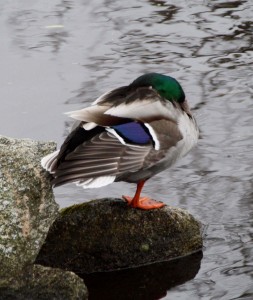 With the colder weather some shallow loch, lochans and ponds freeze over and present a challenge to the water birds that frequent them. Birds such as herons, mallard and dippers then have to leave and seek the more open waters of burns and rivers. However, if the freezing temperatures continue even the burns and slower flowing rivers will freeze over and in extreme cold even the faster rivers will be unsuitable for birds. The commonest of the birds is one of the duck family, the ubiquitous mallard, and although we tend to just accept them, the drakes are really are very attractive birds. This is readily seen in the drake mallard photograph of the bird asleep on the edge of a pond. The females are very drab by comparison but this is because when they are incubating they need to have very good camouflage against predators.
With the colder weather some shallow loch, lochans and ponds freeze over and present a challenge to the water birds that frequent them. Birds such as herons, mallard and dippers then have to leave and seek the more open waters of burns and rivers. However, if the freezing temperatures continue even the burns and slower flowing rivers will freeze over and in extreme cold even the faster rivers will be unsuitable for birds. The commonest of the birds is one of the duck family, the ubiquitous mallard, and although we tend to just accept them, the drakes are really are very attractive birds. This is readily seen in the drake mallard photograph of the bird asleep on the edge of a pond. The females are very drab by comparison but this is because when they are incubating they need to have very good camouflage against predators.
One of the most fascinating of water birds is the smallest of them, the dipper, that frequents burns and rivers. They are remarkable in that they feed by walking under the water. It is almost uncanny to see one walk off the edge of a rock in mid-stream and then re-emerge with a small fish in its beak. The large nest is domed, rather like a larger version of a wren’s nest. This is built under a bridge or, sometimes, under a waterfall. A pair regularly nest under the waterfalls in the RSPB’s Reserve at the Fairy Glen, Rosemarkie on the Black Isle. Many years ago when the bridge was being re-built over the River Nairn at Balnafoich just south of Inverness. I persuaded the engineers to put an artificial dipper’s nest under the bridge and even gave them some plans for the design. A pair of dippers used the box alright but to my embarrassment built their nest on top of the box rather than inside it.
The magnificent herons regularly fish in inland flowing or still waters and will be bold enough visit garden ponds to take goldfish, much to the annoyance of the owners. Contrary to popular belief they will also take a wide variety of food apart from fish. This includes small mammals, ducklings, frogs and even insects. However, fish are their favourite food especially eels and they have their own way of coping with the excessive slime on the bodies of the eels. This could easily contaminate the feathers of the herons but the birds have a special down that combats this.
So these various birds will have to move and there is no recourse, that is if they want to stay in the Highlands, but to move to the coast. Interestingly some of the herons will already be there as they will have chosen to spend all the year round there. A good example of this is the shoreline along the southern part of the inner Beauly Firth and this is especially the case between Inverness and Bunchrew. The reason for birds staying there all the year round is that there is a large heronry in the trees on the western edge of the City so the birds can feed nearby all the year round, including the winter months. Often when I go past in the car I see them either fishing there or asleep with their heads and long necks characteristically tucked under their wings. If you see one fishing then pull over into one of the few lay-byes there and watch them as it is an art in itself to see a heron fishing in the shallows.
Tags: highland birds
